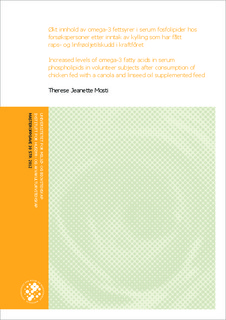| dc.description.abstract | Kjøtt fra kylling fôret med et fôr tilsatt raps- og linfrøolje har et høyere innhold av langkjeda
omega-3 fettsyrer enn kjøtt fra kylling fôret med et tradisjonelt fôr. Imidlertid er effekten av
inntak av dette kjøttet på konsumentens lipidnivåer og blodtrykk, til vår kjennskap, ikke tidligere undersøkt. Hensikten med denne studien var å undersøke hvordan kyllingfôr med høyere innhold av omega-3 (n-3) og lavere innhold av omega-6 (n-6) sammenlignet med tradisjonelt kyllingfôr kan endre sammensetning av n-3 og n-6 i kyllingkjøtt og hvordan inntak av dette kyllingkjøttet
kan påvirke lipidnivåer og blodtrykk hos forsøkspersoner. 600 slaktekyllinger ble fôret opp med fôr tilsatt enten 4 % soyaolje (SO) eller 2 % raps- og 2 % linfrøolje (ROLO). 16 kyllinger fra hver gruppe ble analysert for sammensetning av fettsyrer i
muskel. Deretter ble en dobbeltblindet, randomisert intervensjonsstudie med 46 deltakere utført over en tidsperiode på fire uker. Deltakerne inntok to kyllinger hver i uken, hvor kyllingen enten var fôret på fôr med soyaolje eller raps- og linfrøolje. Umiddelbart før (dag 0) og etter (dag 28)
intervensjonen ble det målt blodtrykk hos deltakerne, og serum fosfolipider (PL) ble analysert for fettsyresammensetning, CRP, HDL- og LDL-kolesterol, totalkolesterol og triglyserider (TG). Høyde og vekt hos deltakerne ble også registrert. Vi fant et signifikant høyere n-3 innhold og signifikant lavere n-6 innhold i kjøtt fra kyllinger
fôret med ROLO-fôr enn hos kyllinger fôret med SO-fôr. For forsøkspersonene var det ingen
forskjell mellom gruppene for blodtrykk, CRP, HDL- og LDL-kolesterol, totalkolesterol og TG i
serum. Innholdet av n-3 fettsyrene alfa-linolensyre (ALA) og eikosapentaensyre (EPA) var signifikant høyere i serum PL hos deltakere i ROLO-gruppen enn hos deltakere i SO-gruppen ved dag 28. Videre var det et signifikant lavere forhold mellom AA og EPA hos deltakere i ROLO-gruppen sammenlignet med deltakere i SO-gruppen ved dag 28.
Inntak av kjøtt fra kylling fôret med fôr tilsatt 2 % raps- og 2 % linfrøolje sammenlignet med
kjøtt fra kylling fôret med 4 % soyaolje kan derfor gi en signifikant økning av innhold av ALA
og EPA i serum PL hos forbrukeren uten at forbrukeren selv trenger å endre sine spisevaner. Meat from chickens fed a feed containing canola and linseed oil has a higher content of long chain omega-3 fatty acids than meat from chickens fed a conventional feed. However, the effect of consumption of this meat on the consumer's lipid levels and blood pressure has, to our knowledge, not previously been examined. The purpose of this study was to examine how feeds with higher levels of omega-3 (n-3) and lower levels of omega-6 (n-6) compared with traditional
feeds can modify the composition of n-3 and n-6 in chicken meat and how the intake of this
chicken meat could affect lipid levels and blood pressure in subjects. 600 broiler chickens were fed a feed containing either 4% soybean oil (SO) or 2% canola and 2% linseed oil (ROLO). 16 chickens from each group were analyzed for composition of fatty acids in
muscle. Subsequently, a double-blind, randomized intervention study with 46 participants was conducted over a period of four weeks. Participants consumed two chickens each week, where the chicken had been fed either the ROLO or the SO feed. Immediately prior to (day 0) and after (day 28) the intervention blood pressure was measured in participants, and serum phospholipids
(PL) were analyzed for fatty acid composition, CRP, HDL-and LDL-cholesterol, total cholesterol
and triglycerides (TG). Height and weight of the participants was also recorded. We found a significantly higher n-3 content and significantly lower n-6 content in meat from chickens fed with ROLO-feed than in chickens fed the SO-feed. For volunteers, there was no
difference between groups for blood pressure, CRP, HDL-and LDL-cholesterol, total cholesterol
and TG in serum. The content of the n-3 fatty acids alpha-linolenic acid (ALA) and
eicosapentaenoic acid (EPA) was significantly higher in the serum phospholipids of participants
in the ROLO group than in participants in the SO group at day 28. Furthermore, there was a
significantly lower ratio between AA and EPA in participants in the ROLO group compared with
participants in the SO group at day 28.
Consumption of meat from chicken fed a feed containing 2% canola and 2% linseed oil
compared with meat from chickens fed a feed with 4% soybean oil may therefore provide a
significant increase in the levels of ALA and EPA in serum phospholipids of the consumer
without the consumer having to change the consumer’s eating habits. | no_NO |
